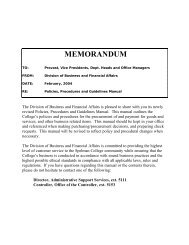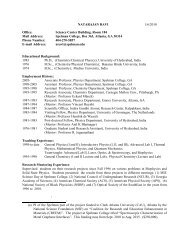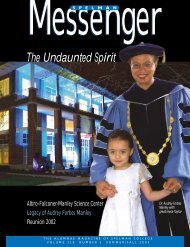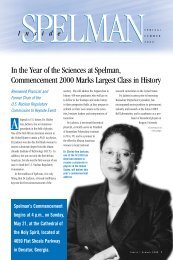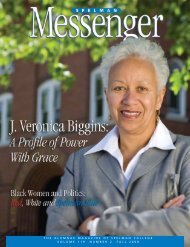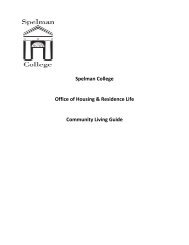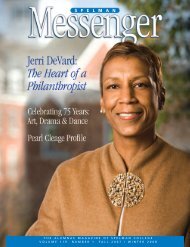(Vol. 114 No. 1) Text (PDF) - Spelman College: Home
(Vol. 114 No. 1) Text (PDF) - Spelman College: Home
(Vol. 114 No. 1) Text (PDF) - Spelman College: Home
- No tags were found...
Create successful ePaper yourself
Turn your PDF publications into a flip-book with our unique Google optimized e-Paper software.
Josephine Harreld Love, C’33,Atlanta Club, 1958Claudia White Harreld, C’01, the daughter of the founderof Morehouse <strong>College</strong>, William Jefferson White, becamethe second president of the Alumnae association in 1923.According to her daughter, Josephine Harreld Love, C’33,who was herself president of the Alumnae Association from1954 to 1959, Claudia White Harreld “became the firstalumnae secretary for the <strong>College</strong>. She prepared exhaustivealumnae records on graduates by obtaining theiroccupations and other information about alumnae.” Thisinformation was used by the institution for reports for theWoman’s American Baptist <strong>Home</strong> Mission Society.Early efforts in the development of the Alumnae Associationfocused on bringing together alumnae within localcommunities for the purpose of obtaining information onalumnae accomplishments and forwarding this data tothe Seminary. Each graduate was expected to give one dollarto support the alumnae fund which was used to purchasebooks for the library. The dollar represented the“dues” or the minimum amount each alumna “owed” to<strong>Spelman</strong>. In 1899, the Association employed one of themissionary graduates, Miss Emma B. Delany, HS’94, to domission work. On May 15, 1898, the alumni of the AtlantaBaptist Seminary and the alumnae of the <strong>Spelman</strong> Seminarycollaborated to publish a literary publication of amonthly magazine called The Athenaeum.First ReunionThe Association’s first alumnae club was comprised ofgraduates and was organized in Atlanta in August, 1914 asThe <strong>Spelman</strong> Graduates Atlanta Club. Following the customof many colleges, President Lucy Tapley suggestedclass reunions so that graduates could meet on certainfixed anniversaries. The Alumnae Association was supportiveof the idea and worked with the <strong>College</strong> to helparrange the first reunion May 1915. The proposed plancalled for each class to hold a reunion on the followinganniversaries; the first, the third, the fifth, the tenth, thefifteenth, the twentieth and every five years thereafter.Therefore for the inaugural May 1915 reunion, alumnaefrom the classes 1914, 1912, 1910, 1900, 1895 and 1890were expected to return to <strong>Spelman</strong> for class meetings.Clubs Created in the TwentiesMost of the clubs organized in the twenties were located inGeorgia and Florida. However, Chicago, Cleveland, PrairieView (Texas) and Detroit also initiated clubs. A rallying sloganwas crafted, “Wherever there are four or five graduatesor ex-students, we will start a <strong>Spelman</strong> Club.” The Packard-Giles Club in Atlanta was organized for ex-students onMarch 16, 1921. The purpose of this club was to “keep alivethe spirit of the founders by doing uplifting work.” In April,1923, the <strong>Spelman</strong> Graduates Atlanta Club gave to worthycauses like the Associated Charities. The Alumnae Associationas a whole identified goals that sparked focused effortsamong the local clubs. One such goal was to support theLibrary Endowment Fund where proceeds of the fund wouldbe used to purchase books for the library. Through theestablishment of an endowment, this fund provided a permanentsource of income to purchase books. A pageantentitled “The Star” was first produced by the <strong>Spelman</strong> GraduatesAtlanta Club to generate funds for the alumnae fund— an unrestricted annual giving effort. One of the firstrestricted fundraising efforts embarked by the AlumnaeAssociation was the Grover-Werden Fountain which wasdedicated in May 1927. The significance of this effort wasthat the fountain was the only place in the campus area thatanyone could get cold drinking water. <strong>No</strong>t only did students,faculty and staff enjoy the water but community residentscould drink from the fountain due to its easy access.In 1923, aware of the difficulty experienced by facultyin moving around the city, automobile transportation wasprovided by the members of the <strong>Spelman</strong> GraduatesAtlanta Club to visit the leading Negro enterprisesin Atlanta. The purpose of the outings was to educate thefaculty and ultimately help students to connect their studieswith the realities of the growing and prosperous Negrocommunity in Atlanta. The faculty visited the AshbyHeights community, Auburn Avenue, the Citizens TrustBank and the Standard Life Insurance Company. Between1887 and 1928, the potential pool of alumnae who couldwork within the Association had expanded due to the 1200degrees and diplomas which had been awarded by <strong>Spelman</strong><strong>College</strong> (Atlanta Female Baptist Seminary).Honors Day, 1958Photos: <strong>Spelman</strong> ArchivesThe Thirties — The Loyalty FundThe thirties revealed club development in Alabama andLouisiana. In 1933, the Packard-Giles Club purchased anew flagpole for the <strong>College</strong>. The most significant developmentfor the <strong>College</strong> as a result of the efforts of the AlumnaeAssociation was the Loyalty Fund, which was the firstreunion giving program. This was initiated by the alumnaewith the encouragement of the <strong>College</strong>. The Class of1929, at their ten-year reunion in 1939, pledged to giveannually to the <strong>College</strong>. Each class was to give during thereunion and designate the gift for the <strong>Spelman</strong> <strong>College</strong>20S P E L M A N M E S S E N G E R




